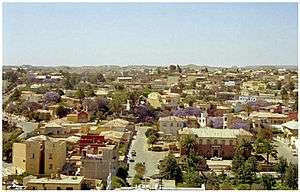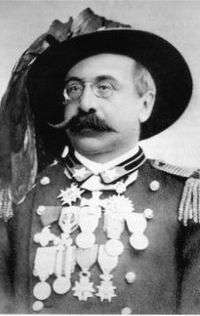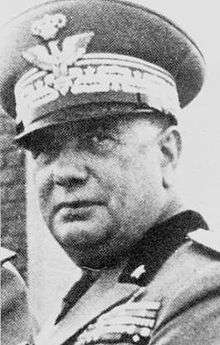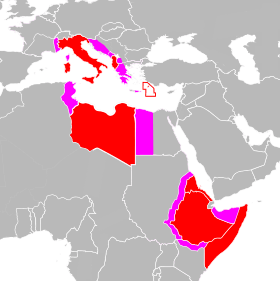Italian Eritrea
| Italian Eritrea | ||||||||||
| Colonia Eritrea | ||||||||||
| Colony of Italy | ||||||||||
| ||||||||||
| ||||||||||
.svg.png) | ||||||||||
| Capital | Asmara | |||||||||
| Languages | Italian (official) Tigrinya, Hejazi Arabic | |||||||||
| Religion | Catholicism Oriental Orthodoxy Islam, | |||||||||
| Political structure | Colony | |||||||||
| Governor | ||||||||||
| • | 1890 | Baldassarre Orero | ||||||||
| • | 1935-1936 | Pietro Badoglio | ||||||||
| Historical era | Scramble for Africa | |||||||||
| • | Established | 1890 | ||||||||
| • | Disestablished | 1936 | ||||||||
| Area | ||||||||||
| • | 1936 | 121,000 km² (46,718 sq mi) | ||||||||
| Population | ||||||||||
| • | 1936 est. | 1,000,000 | ||||||||
| Density | 8.3 /km² (21.4 /sq mi) | |||||||||
| Currency | Eritrean tallero (1890-1921) Italian lira (1921-36) | |||||||||
| ||||||||||
Italian Eritrea was a colony of the Kingdom of Italy in the territory of present-day Eritrea. Although it was formally created in 1890, the first Italian settlements in the area were established in 1882 around Assab. The colony officially lasted until 1947.[1]
History
Acquisition of Assab and creation of the colony


Part of a series on the |
|---|
| History of Eritrea |
.svg.png) |
| Pre-colonial |
| Colonial |
| Post-colonial |
| State of Eritrea |
|
|
In 1869[2][3] the lands surrounding the Bay of Assab was bought by the Rubattino Shipping Company from the minor sultan of nearby Raheita[3] to serve as a coaling station along the shipping lanes introduced by the recently completed Suez Canal. The area—long dominated by the Ottoman Empire and Egypt[4]—was not settled by the Italians until 1880;[3] two years later, the Kingdom of Italy took possession of the nascent colony from its commercial owners.
Most of the western coast of the Red Sea was then formally claimed by the Khedivate of Egypt (under the notional rule of the Ottoman Turkish Empire, who held the eastern coast) but the region was thrown into chaos by major Egyptian defeats in the Ethio-Egyptian War and by the success of the Mahdi's uprising in the Sudan. In 1884, the British Hewett Treaty promised the Bogos—the highlands of modern Eritrea—and free access to the Massawan coast to Emperor Yohannes IV in exchange for his help evacuating garrisons from the Sudan;[5] In the vacuum left by the Egyptian withdrawal, though, British diplomats were concerned about the rapid expansion of French Somaliland, France's colony along the Gulf of Tadjoura. Ignoring their treaty with Ethiopia, they openly encouraged Italy to expand north into Massawa, which was taken without a shot from its Egyptian garrison. Located on a coral island[6] surrounded by lucrative pearl-fishing grounds,[7] the superior port was fortified and made the capital of the Italian governor.[6] Assab, meanwhile, continued to find service as a coaling station.[2] As they were not a party to the Hewett Treaty, the Italians began restricting access to arms shipments and imposing customs duties on Ethiopian goods immediately.

In the disorder that followed the 1889 death of Emperor Yohannes IV, Gen. Oreste Baratieri occupied the highlands along the Italian coast and Italy proclaimed the establishment of a new colony of Eritrea (from the Latin name for the Red Sea). In the Treaty of Wuchale (It. Uccialli) signed the same year, King Menelik of Shewa—a southern Ethiopian kingdom—recognized the Italian occupation of his rivals' lands of Bogos, Hamasien, Akkele Guzay, and Serae in exchange for guarantees of financial assistance and continuing access to European arms and ammunition. His subsequent victory over his rival kings and enthronement as Emperor Menelek II (r. 1889–1913) made the treaty formally binding upon the entire country. Once established, however, Menelik took a dim view towards Italian involvement with local leaders in his northern province of Tigray;[8] while the Italians, for their part, felt bound to involvement given the regular Tigrayan raiding of tribes within their colony's protectorate[7] and the Tigrayan leaders themselves continued to claim the provinces now held by Italy. Negotiations with the French over a railway brought things to a head: the Italian—but not Amharic—version of the Treaty of Wuchale had prohibited Ethiopia with foreign negotiations except through Italy, effectively making the realm an Italian protectorate. Secure both domestically and militarily (thanks to arms shipments via French Djibouti and Harar), Menelik denounced the treaty in whole and the ensuing war, culminating in Italy's disastrous defeat at Adwa, ended their hopes of annexing Ethiopia for a time.
During the late twentieth century Assab would become Ethiopia's main port, but it was long overshadowed by nearby Djibouti, whose railway (completed to Dire Dawa in 1902) permitted it to quickly supplant traditional caravan-based routes to Assab[7] and Zeila.[8][9][10] Massawa remained the primary port for most of northern Ethiopia, but its relatively high customs dues, dependence on caravans, and political antagonism limited the volume on its trade with Ethiopia.[7]

Seeking to develop their own lands, the Italian government launched the first development projects in the new colony in the late 1880s. The Eritrean Railway was completed to Saati in 1888[11] and reached Asmara in the highlands in 1911.[12] The Asmara–Massawa Cableway (dismantled by the British as war reparations in World War II) was the longest line in the world during its time. Italian administration of Eritrea also brought improvements in the medical and agricultural sectors of Eritrean society. Despite an imposition of racial laws, all urban Eritreans had access to modern sanitation and hospital services. The Italians also employed local Eritreans in public service, particularly the police and public works departments. In a region marked by cultural, linguistic, and religious diversity, a succession of Italian governors maintained a notable degree of unity and public order.
Nicknamed Colonia Primogenita ("First-born Colony") in contrast to the newer and less-developed territories of Italian Somaliland and Libya,[13] Eritrea boasted a larger native Italian settlement than the other lands. The first few dozen families were sponsored by the Italian government around the start of the 20th century and settled around Asmara and Massawa. The Italian-Eritrean community then grew from around 4,000 during World War I to nearly 100,000 at the beginning of World War II.[14] While tolerating Islamic adherence, the Italians endorsed a huge expansion of Catholicism in Eritrea and constructed many churches in the highlands around Asmara and Keren, centered on the St Joseph Cathedral in the capital. By the early 1940s, Catholicism was the declared religion of around 28% of the colony's population.[15]
Fascist Era
.svg.png)
Benito Mussolini's rise to power in Italy in 1922 brought profound changes to the colonial government in Eritrea. After il Duce declared the birth of Italian Empire in May 1936, Italian Eritrea (enlarged with northern Ethiopia's regions) and Italian Somaliland were merged with the just conquered Ethiopia in the new Italian East Africa (Africa Orientale Italiana) administrative territory. This Fascist period was characterized by imperial expansion in the name of a "new Roman Empire".
Eritrea was chosen by the Italian government to be the industrial center of Italian East Africa:[16]
The capital of Eritrea experienced a huge increase in population: in 1935 there were only 4000 Italians and 12000 Eritreans, while in 1938 there were 48000 Italians and 36000 Eritreans. Historian Gian Luca Podesta wrote that practically Asmara has become an Italian city ("in pratica Asmara era diventata una citta' italiana").[17]
After the establishment of new transportation and communication methods in the country, the Italians also started to set up new factories, which in turn made due contribution in enhancing trade activities. The newly opened factories produced buttons, cooking oil, and pasta, construction materials, packing meat, tobacco, hide and other household commodities. In the year 1939, there were around 2,198 factories and most of the employees were Eritrean citizens, some even moved from the villages to work in the factories.The establishment of industries also made an increase in the number of both Italians and Eritreans residing in the cities. The number of Italians residing in the country increased from 4,600 to 75,000 in five years; and with the involvement of Eritreans in the industries, trade and fruit plantation was expanded across the nation, while some of the plantations were owned by Eritreans.[18]
The Italian government continued to implement agricultural reforms but primarily on farms owned by Italian colonists (exports of coffee boomed in the 1930s). In the area of Asmara, there were in 1940 more than 2,000 small and medium-sized industrial companies, which were concentrated in the areas of construction, mechanics, textiles, food processing and electricity. Consequently, the standard of living in Eritrea in 1939 was considered among the best on the continent for both the local Eritreans and the Italian settlers.[19]
Mussolini's government considered the colony as a strategic base for future aggrandizement and ruled accordingly, using Eritrea as a base to launch its 1935–1936 campaign to conquer and colonize Ethiopia. Even in World War II the Italians used Eritrea to attack Sudan and occupy the Kassala area. Indeed, the best Italian colonial troops were the Eritrean Ascari, as stated by Italian Marshall Rodolfo Graziani and legendary officer Amedeo Guillet.[20] Furthermore, after World War I, service with the Ascari become the main source of paid employment for the indigenous male population of Italian Eritrea. During the expansion required by the Italian invasion of Ethiopia in 1936, 40% of eligible Eritreans were enrolled in these colonial troops.[21]
According to the Italian census of 1939 the city of Asmara had a population of 98,000, of which 53,000 were Italians. This fact made Asmara the main "Italian town" of the Italian empire in Africa. Furthermore, because of the Italian architecture of the city, Asmara was called Piccola Roma (Little Rome).[22] In all Eritrea the Italians were 75,000 in that year.[23]

Asmara was known to be an exceptionally modern city, not only because of its architecture, but Asmara also had more traffic lights than Rome did when the city was being built. The city incorporates many features of a planned city. Indeed, Asmara was an early example of an ideal modern city created by architects, an idea which was introduced into many cities across the world, such as Brasilia, but which was not altogether popular. Features include designated city zoning and planning, wide treed boulevards, political areas and districts and space and scope for development. Asmara was not built for the Eritreans however; the Italians built it primarily for themselves and made the city a typical Italian city with even its own car race (called the Asmara circuit).
The city has been regarded as "New Rome" due to its quintessential Italian touch, not only for the architecture, but also for the wide streets, piazzas and coffee bars. While the boulevards are lined with palms and indigenous shiba'kha trees, there are numerable pizzerias and coffee bars, serving cappucinos and lattes, as well as ice cream parlours.
Many industrial investments were endorsed by the Italians in the area of Asmara and Massawa, but the beginning of World War II stopped the blossoming industrialization of Eritrea.[24]
British occupation and the end of the colony
When the British army conquered Eritrea in January 1941, most of the infrastructures and the industrial areas were extremely damaged and the remaining ones (like the Asmara-Massawa Cableway) were successively removed and sent toward India and British possessions in Africa as a war booty.[25]

The following Italian guerrilla war was supported by many Eritrean colonial troops (like the "hero" of Eritrean independence, Hamid Idris Awate ) [26] until the Italian armistice in September 1943. Eritrea was placed under British military administration after the Italian surrender in World War II.
The Italians in Eritrea started to move away from the country after the defeat of the Kingdom of Italy by the Allies, and by the time of the British census of 1949 Asmara had only 17,183 Italian Eritreans of a total population of 127,579. Most Italian settlers left for Italy, with others to United States, Middle East, and Australia.
The British maintained initially the Italian administration of Eritrea, but the country soon started to be involved in a violent process of independence (from the British in the late forties and after 1952 from the Ethiopians, who annexed Eritrea in that year).
During the last years of World War II some Italian Eritreans like Dr. Vincenzo Di Meglio defended politically the presence of Italians in Eritrea and successively promoted the independence of Eritrea.[27] He went to Rome to participate in a Conference for the independence of Eritrea, promoted by the Vatican.

After the war Di Meglio was named Director of the "Comitato Rappresentativo Italiani dell' Eritrea" (CRIE). In 1947 he supported the creation of the "Associazione Italo-Eritrei" and the "Associazione Veterani Ascari", in order to get alliance with the Eritreans favorable to Italy in Eritrea.[28]
As a result of these creations, he cofounded the "Partito Eritrea Pro Italia" (Party of Shara Italy) in September 1947, an Eritrean political Party favorable to the Italian presence in Eritrea that obtained more than 200,000 inscriptions of membership in one single month.
Indeed, the Italian Eritreans strongly rejected the Ethiopian annexation of Eritrea after the war: the Party of Shara Italy was established in Asmara in 1947 and the majority of the members were former Italian soldiers with many Eritrean Ascari (the organization was even backed up by the government of Italy).
The main objective of this party was Eritrea freedom, but they had a pre-condition that stated that before independence the country should be governed by Italy for at least 15 years.
With the Peace Treaty of 1947 Italy officially accepted the end of the colony. As a consequence the Italian community started to disappear, mainly after the Ethiopian government took control of Eritrea.
Governors of Italian Eritrea


- Colonia Primigenia
- Baldassarre Orero from January 1890 to June 1890
- Antonio Gandolfi from June 1890 to February 1892
- Oreste Baratieri from February 1892 to February 1896
- Antonio Baldissera from February 1896 to December 1897
- Ferdinando Martini from February 1897 to March 1907
- Giuseppe Salvago Raggi from March 1907 to August 1915
- Giovanni Cerrina Feroni from August 1915 to September 1916
- Giacomo De Martino from September 1916 to July 1919
- Camillo De Camillis from July 1919 to November 1920
- Ludovico Pollera from November 1920 to April 1921
- Giovanni Cerrina Feroni from April 1921 to June 1923
- Giacopo Gasparini from June 1923 to June 1928
- Corrado Zoli from June 1928 to July 1930
- Riccardo Di Lucchesi from July 1930 to January 1935
- Emilio De Bono from January 1935 to November 1935
- Pietro Badoglio from November 1935 to May 1936
- Governorate of Eritrea
- Alfredo Guzzoni from May 1936 until April 1937
- Vincenzo De Feo from April 1937 until December 1937
- Giuseppe Daodice from December 1937 until June 1940
- Luigi Frusci from June 1940 until May 1941
See also
References
- ↑ Essay on Italian Eritrea, 1953 (in Italian)
- 1 2 Ullendorff, Edward. The Ethiopians: An Introduction to Country and People 2nd ed., p. 90. Oxford University Press (London), 1965. ISBN 0-19-285061-X.
- 1 2 3 "Assab" in the Encyclopædia Britannica 11th ed, Vol. 2. 1911. Hosted at Wikisource.
- ↑ "Egypt" in the Encyclopædia Britannica 11th ed. 1911.
- ↑ Wylde, Augustus B. Modern Abyssinia, pp. 35 ff. Methuen (London), 1901.
- 1 2 "Massawa" in the Encyclopædia Britannica 11th ed, Vol. 17. 1911. Hosted at Wikisource.
- 1 2 3 4 "Eritrea" in the Encyclopædia Britannica 11th ed., Vol. 9. 1911. Hosted at Wikisource.
- 1 2 "Abyssinia" [i.e., Ethiopia] in the Encyclopædia Britannica 11th ed., Vol. 1. 1911. Hosted at Wikisource.
- ↑ "Zaila" [i.e., Zeila] in the Encyclopædia Britannica 11th ed, Vol. 28. 1911. Hosted at Wikisource.
- ↑ "Somaliland, French" [i.e., Djibouti] in the Encyclopædia Britannica 11th ed, Vol. 25. 1911. Hosted at Wikisource.
- ↑ Cf. engineer Emilio Olivieri's report on the construction of the Massawa–Saati Railway (1888), hosted at Ferrovia Eritrea. (Italian)
- ↑ "Eritrean Railway" at Ferrovia Eritrea. Template:It-icon
- ↑ "The beginning of the Italian colony of Eritrea: Assab" Template:It-icon
- ↑ "Italian emigration to Eritrea". Template:It-icon
- ↑ Bandini, Franco. Gli italiani in Africa, storia delle guerre coloniali 1882-1943, "Eritrea". Template:It-icon
- ↑ Italian industries in colonial Eritrea
- ↑ Gian Luca Podesta: "Le citta' dell'impero" (in Italian)
- ↑ Italian administration in Eritrea
- ↑ Eritrea 1940
- ↑ Amedeo Guillet in Eritrea
- ↑ Ascari: the brave Italian soldiers of color
- ↑ Italian architectural planification of Asmara (in Italian) p. 64-66
- ↑ Italians in 1939 Eritrea
- ↑ Italian industries and companies in Eritrea
- ↑ Chapter on Eritrea under the British
- ↑ Rosselli, Alberto. Storie Segrete. Operazioni sconosciute o dimenticate della seconda guerra mondiale. second chapter
- ↑ Franco Bandini. Gli italiani in Africa, storia delle guerre coloniali 1882-1943 p. 67
- ↑ http://www.ilcornodafrica.it/st-sci03.htm
Bibliography
- Bandini, Franco. Gli italiani in Africa, storia delle guerre coloniali 1882-1943. Longanesi. Milano, 1971.
- Bereketeab, R. Eritrea: The making of a Nation. Uppsala University. Uppsala, 2000.
- Lowe, C.J. Italian Foreign Policy 1870-1940. Routledge. 2002.
- Maravigna, Pietro. Come abbiamo perduto la guerra in Africa. Le nostre prime colonie in Africa. Il conflitto mondiale e le operazioni in Africa Orientale e in Libia. Testimonianze e ricordi. Tipografia L'Airone. Roma, 1949.
- Negash, Tekeste. Italian colonialism in Eritrea 1882-1941 (Politics, Praxis and Impact). Uppsala University. Uppsala, 1987.
- Podesta, Gian Luca et al. Lo sguardo della storia economica sull'edilizia urbana. Volume 4. Chapter: "Le citta dell'impero". Publisher Croma - Università Roma TRE. Roma, 2009. ISBN 888368107X
- Rosselli, Alberto. Storie Segrete. Operazioni sconosciute o dimenticate della seconda guerra mondiale. Iuculano Editore. Pavia, 2007
- Mauri, Arnaldo. Eritrea's early stages in monetary and banking development, International Review of Economics, Vol. LI, N°. 4, 2004.
- Tuccimei, Ercole. La Banca d'Italia in Africa, Foreword by Arnaldo Mauri,Collana storica della Banca d'Italia, Laterza, Bari, 1999.
External links
- Old photos of Italian Eritrea
- Website with photos of Italian Asmara
- Postcards of Italian Asmara
- Website with documents, maps and photos of the Italians in Eritrea (in Italian)
- Detailed map of Eritrea in 1936 (click on the sections to enlarge)
- "1941-1951 The difficult years" (in Italian), showing the end of Italian Eritrea`f
.svg.png)


